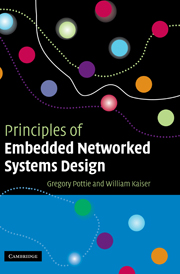Book contents
- Frontmatter
- Contents
- Preface
- Acknowledgments
- List of Abbreviations
- 1 Embedded network systems
- 2 Representation of signals
- 3 Signal propagation
- 4 Sensor principles
- 5 Source detection and identification
- 6 Digital communications
- 7 Multiple source estimation and multiple access communications
- 8 Networking
- 9 Network position and synchronization services
- 10 Energy management
- 11 Data management
- 12 Articulation, mobility, and infrastructure
- 13 Node architecture
- 14 Network data integrity
- 15 Experimental systems design
- 16 Ethical, legal, and social implications of ENS
- 17 Design principles for ENS
- Appendix A Gaussian Q function
- Appendix B Optimization
- Index
11 - Data management
Published online by Cambridge University Press: 10 August 2009
- Frontmatter
- Contents
- Preface
- Acknowledgments
- List of Abbreviations
- 1 Embedded network systems
- 2 Representation of signals
- 3 Signal propagation
- 4 Sensor principles
- 5 Source detection and identification
- 6 Digital communications
- 7 Multiple source estimation and multiple access communications
- 8 Networking
- 9 Network position and synchronization services
- 10 Energy management
- 11 Data management
- 12 Articulation, mobility, and infrastructure
- 13 Node architecture
- 14 Network data integrity
- 15 Experimental systems design
- 16 Ethical, legal, and social implications of ENS
- 17 Design principles for ENS
- Appendix A Gaussian Q function
- Appendix B Optimization
- Index
Summary
This chapter provides a brief introduction to database design principles before describing how the problems of data management in ENS differ from conventional applications. In particular, the fact of dealing with the potentially infinite data generated by the physical world as compared with the limited queries for information or action posed by the end-users needs to be reconciled. The data management strategy also has a large impact on the energy budget, to the point that it is difficult to fully separate signal processing, database, and networking problems in large-scale networks. The chapter concludes with consideration of higher-level reasoning on the data, using the theories of logic and language.
Database design principles
Relational databases
A database may be defined as a set of persistent data to be used by applications, where persistence implies the data can be deleted only by explicit command. The data describe some entity, which may be a physical object, collection of objects, or a set of relationships among objects. The entity is characterized by properties such as location, size, number, priorities, and so forth, which are recorded within the database. In a relational database, the data are represented as rows in tables that may be directly interpreted as true propositions, while the operators work on the rows of the tables to produce new tables that are also collections of true propositions. Consider, e.g., Table 11.1, which consists of a series of true propositions from the children's book Green Eggs and Ham by Dr. Seuss.
- Type
- Chapter
- Information
- Principles of Embedded Networked Systems Design , pp. 331 - 367Publisher: Cambridge University PressPrint publication year: 2005



